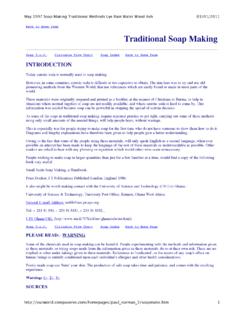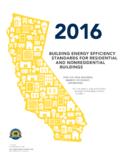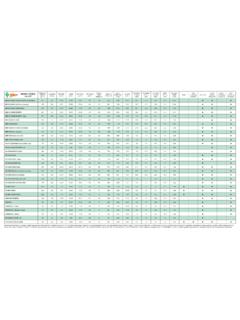Transcription of Exercises in Physics - myreaders.info
1 Exercises in PhysicsJennifer Bond HickmanNeedham, MassachusettsUpper Saddle River, New JerseyGlenview, IllinoisTo my grandfather, C. Lawrence BondWhen I was 10 years old, you paid me 10 to write a book for you. I ve finally finished it!Illustrations by Jennifer Bond Photograph: Motor Press Agent/Superstock, of the designations used by manufacturers and sellers to distinguishtheir products are claimed as trademarks. Where such a designation appearsin this book, and the publisher was aware of a trademark claim, thedesignations have been printed in initial caps ( , Macintosh).Copyright 2002 by Prentice-Hall, Inc., Upper Saddle River, New rights reserved. Printed in the United States of America. Thispublication is protected by copyright, and permission should be obtainedfrom the publisher prior to any prohibited reproduction, storage in a retrievalsystem, or transmission in any form or by any means, electronic, mechanical,photocopying, recording, or likewise.
2 For information regardingpermission(s), write to: Rights and Permissions 0-13-054275-X 26 V031 13 12 11 ContentsiiiPreface to Students:Welcome to Physics !iv1 Motion11-1 Speed, Velocity, and Acceleration11-2 Free Fall82 Vectors and Projectiles152-1 Vectors and Scalars152-2 Projectile Motion213 Forces293-1 Forces and Acceleration293-2 Friction353-3 Statics383-4 Pressure444 Momentum514-1 Impulse and Momentum514-2 Conservation of Momentum555 Energy and Machines635-1 Work and Power635-2 Energy665-3 Machines and Efficiency726 Circular and Rotational Motion816-1 Centripetal Acceleration and Force816-2 Torque876-3 Moment of Inertia and Angular Momentum917 Law of Universal Gravitation977-1 Gravitational Force977-2 Gravitational Acceleration1017-3 Escape Speed1048 Special Relativity1098-1 Time Dilation1098-2 Relativistic Length and Energy1139 Solids, Liquids.
3 And Gases1199-1 Density1199-2 Solids1219-3 Liquids1249-4 Gases13010 Temperature and Heat13510-1 Temperature and Expansion13510-2 Heat14011 Simple Harmonic Motion14911-1 Springs14911-2 Pendulums15312 Waves and Sound15912-1 Wave Motion15912-2 Doppler Effect16112-3 Standing Waves16513 Reflection and Refraction17113-1 The Speed of Light17113-2 Reflection17313-3 Refraction17714 Lenses, Diffraction, and Interference18314-1 Lenses, Telescopes, andMagnifying Glasses18314-2 Eyeglasses18914-3 Diffraction and Interference19215 Electrostatics19715-1 Electrostatic Force19715-2 Electric Field20015-3 Electrical Potential Difference20316 Direct Current Circuits20916-1 Current and Resistance20916-2 Capacitance21216-3 Power21416-4 Series and Parallel Circuits21717 Magnetism and ElectromagneticInduction22517-1 Magnetic Forces and Fields22517-2 Electromagnetic Induction22718 Modern Physics23318-1 The Atom and the Quantum23318-2 The Photoelectric Effect23618-3 Energy Level Diagrams23918-4 Radioactivity241 Appendix A: Working With Numbers247 Significant FiguresUnit ConversionsSome Simple Trigonometry RelationshipsSome Common PrefixesAppendix B.
4 Selected Answers249ivWelcome to Physics !Studying Physics is exciting because it can help you answer many questionsabout how and why our world works. Your workbook is designed to takesome real-life situations and examine them with the use of equations, a taskoften referred to as problem solving, however, is more thanjust solving numerical Exercises by doing calculations. Using mathematics isonly one way to obtain a solution. Another effective method of problemsolving involves drawing on conceptual understanding to explain how theworld works and applying those concepts in the laboratory. Like scientists, weperform experiments to test our hypotheses. Until we can understand theconcepts and have the opportunity to make our own discoveries, the numbersand equations of Physics are meaningless.
5 In the words of Paul G. Hewitt,author of Conceptual Physics , Formulas [should be used] as guides tothinking.. We [must] learn to conceptualize before we learn to compute. This book is not meant to stand alone. It is not meant to replace your physicstext, the laboratory work that you do, or your Physics teacher. Its purpose isto reinforce the concepts that you have already learned in class and to giveyou the opportunity to try some calculations with your teacher s help. If youhave had difficulty solving word problems in the past, rely on yourconceptual understanding of the Physics to reason out what should behappening before beginning your mathematical solution. The procedureoutlined in the next section will lead you step-by-step through the exercisesand make learning to do simple computations a little to Use This BookAs you begin to use this book, you will discover that the word problemhasbeen replaced with the word Physics exercise does not reallybecome a problem until you accept the challenge it offers and attempt to solveit.
6 Once you have chosen to make it yourproblem, you have a personalinterest in finding the chapter of this workbook is divided into two or more topic sections thatbegin with some Physics theory. This theory section provides a very briefreview of the concepts and equations your teacher has discussed in class, andisnotan introduction to new material. It is presumed that you have alreadylearned everything in the theory section before beginning the Exercises . Thisreview is simply a reminder and a place to find all the equations you the theory, there is a section called Solved Examples, where thetheory is applied to Exercises similar to those you will be expected to solvelater. Solutions are organized to make it easy to follow a calculation frombeginning to end.
7 Most solved examples are in the following :States the known values Unknown:Lists the unknown you are in the equation:Shows the equationin its original :Shows the equation set up in terms of the unknown, substitutes thenumerical values, and solves for the unknown. The answer is thenwritten with the correct units and shown in boldface type for section of Practice Exercises allows you to apply some of the skills you havelearned to new more practice, at the end of each chapter there is a section of AdditionalExercises, which require the same level of understanding as the PracticeExercises. The final section, called Challenge Exercises for Further Study,contains Exercises requiring more complex calculations. Challenge Exercisesare intended for you to use after you have mastered the skills used in earlierexercises and are anxious to take on some more rigorous the end of the workbook, some Selected Answers will allow you to checkyour the Right RecipeSolving Physics Exercises is much like baking a cake.
8 The first time you try todo it, you must read the recipe very carefully and use exactly the ingredientslisted. The next time, you are a little less nervous about how well the cake willturn out. Pretty soon you can make the cake without having to read the recipeat all. You eventually become so comfortable making cakes that you are ableto experiment by adding ingredients in a different order or changing therecipe slightly to make the cake even better. When solving Physics Exercises ,you will find it easy to follow the prescribed recipe shown in the SolvedExamples. After trying a few Exercises , you will have started to develop astrategy for constructing your solution that you can retain throughout theentire book. As you get better and better at doing calculations and youdevelop a greater conceptual understanding of the Physics involved, you mayeven come up with an alternative method of solving an exercise that isdifferent from the one used in this book.
9 If so, congratulations! You have donejust what the physicist does when he or she tries to find a solution. Be sure toshow your teacher and classmates your alternative approach. It is valuable tolook at many different solutions to the same Alternative to Counting on Your FingersEarly scientists had to make all of their calculations by hand. Later, the sliderule made calculations a little quicker. Today s tool is the hand-held pocketcalculator. To save time, you are encouraged to do your calculations with theuse of a calculator, but be sure that you first understand whyyou are doingthem. Remember, it s important to know how to operate without a calculatoras well. Many students rely so heavily on their calculator that they begin tolose the skill of doing calculations by hand.
10 It is extremely important to beable to add, subtract, multiply, divide, and square numbers. You shouldvpractice working with exponents (called scientific notation) and estimatinganswers to the nearest power of ten because you may not always have acalculator handy!How Much is Too Much?When making measurements, you may have measurement tools that allowyou only a certain degree of precision. For example, you may be able tomeasure your friend s height to the nearest millimeter, but estimating it anycloser is difficult. You may say his height is 1536 mm or, in other words, m. Since we don t know what comes after the 6, we say that this numbercontains 4 significant figures. Each one can be accurately measured. Whenadding, subtracting, multiplying, and dividing numbers, it is important tokeep significant figures in mind.







